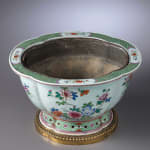Unknown
A very beautiful Louis XVI gilt bronze mounted Qianlong famille-rose porcelain jardinière with a drainage hole at the base and tin liner, the jardinière with an everted quatrefoil-shaped rim painted with floral sprays within four shaped panels reserved on a green lattice diaper ground with an iron red scrolled band below the rim, the shaped bowl painted with chrysanthemums, tree peonies and various insects, on a pierced elliptical foot decorated with flower heads on a green geometric diaper ground above a pink and then iron red geometric band, mounted on a conformingly shaped gilt bronze stepped and lobed base
The porcelain: China, probably Jingdezhen, date circa 1735-45.
The gilt bronze: Paris, mid eighteenth century
Height 25 cm, width 40.5 cm, depth 35 cm.
This jardinière represents a style of Chinese ceramic known in the West as famille-rose or fencai (powdery colours) in China, which is considered by many to be the highest form of Chinese overglaze enamel decorated porcelain. First introduced around the end of the 1720s, it exemplifies the taste for exotic objects that dominated the Qing court under the Qianlong Emperor (1736-95). It was created from white porcelain clay that was covered with an opaque white glaze before being fired at a very high temperature. The decorative motifs were then applied to the glazed body using brightly coloured famille-rose enamel pigments that were fixed to the vase by a second firing at a much lower temperature. The distinctive famille-rose palette replaced the earlier famille-verte used during the earlier part of the reign of the Chinese Emperor K'ang Hsi (1662-1722). Famille-rose pigments developed from a combination of Chinese and Western enamels. Inspired by the East, European artists eagerly tried to reproduce Chinese porcelains and glazes and in about 1680 Andreas Cassius of Leyden, Holland developed a new rose-red colour from gold chloride and tin. When Chinese craftsmen adopted the colour, known as yang ts'ai, meaning foreign colour, circa 1722 it proved immensely popular.
Among other polychrome enamels were famille-jaune (yellow family) and famille-noire (black family of mid 19th century origin). The classification into families was introduced during the 1800's by the French writer, A. Jacquemart. Generally purer in composition than earlier Chinese enamels, the new famille-rose enamels offered a brighter palette, greater opacity as well as mixing and application qualities that were similar to paint. Although Chinese potters had painted pictorial designs for hundreds of years before the Qing dynasty, the invention of these new enamels during the 18th century enabled them to decorate their wares in a much wider range of styles than ever before. Nearly all Chinese porcelain intended for export was made in the Imperial factory at Jingdezhen, near Nanking. The Imperial factory, founded in 1369 produced nearly all the finest Chinese porcelain from the Ming period onward. Pieces decorated in underglaze blue were painted in the same town but wares with polychrome painting such as the present example, were generally decorated in specialised enamelling shops in the Treaty Port of Canton, where Cantonese enamels were also manufactured.
The vogue for mounting Chinese export porcelain, which goes back to the Renaissance, enjoyed a great revival during the eighteenth century when the Parisian marchands-merciers catered for the inexhaustible demand for mounted porcelains amongst the fashionable members of society. The marchands-merciers would have masterminded their final assembly, having firstly purchased the porcelain directly from one of the East Indies companies and then would have commissioned one of the Parisian bronziers to create a suitable fashionable mount for it.



